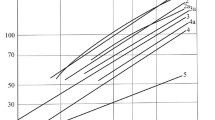Processes that arise in the course of heating of liquid hydrocarbon mixtures in the channels of heat exchangers containing process intensifiers are considered. Random metal packings and coiled elements are used as the intensifiers. Using a cellular model of the flow structure, an expression is derived for calculating the temperature profile of the heated medium along the length of the channel. Formulas for calculating the Nusselt number in a channel containing intensifiers as well as the modified Péclet number of the flow structure are presented. Sample calculations of the process of heating of turbine oils and marine diesel oil are provided. A significant increase in the efficiency of heat transfer (more than eight-fold) and the force factor (more than fivefold) is demonstrated.



Similar content being viewed by others
References
F. A. Dreitser and I. F. Lobanov, “Limiting intensification of heat transfer in tubes through artificial turbulization of the flow,” Inzh.-Fizich. Zh., 16, No. 1, 46−51 (2013).
V. K. Migai, Increasing the Efficiency of Modern Heat Exchangers [in Russian], Energiya, Leningrad (1980).
Yu. G. Nazmeev, Heat Exchange in Laminar Flow of Fluids in Discrete Rough Channels [in Russian], Energoatomizdat, Moscow (1998).
I. A. Popov, Yu. F. Gortyshov, and V. V. Olimpiev, “Industrial application of intensification of heat transfer – the modern state of the problem,” Teploenergetika, No. 1, 3−12 (2012).
S. L. Demenok, S. M. Sivukha, and V. V. Medvedev, Hydrodynamics and Heat Exchange in Spherical Packing [in Russian], Strata, St. Petersburg (2015).
A. G. Laptev, T. M. Farakhov, and O. G. Dudarovskaya, Efficiency of Transfer Phenomena in Channels with Random Packing Layers [in Russian], Strata, St. Petersburg (2016).
I. A. Popov, Hydrodynamics and Heat Exchange in Porous Heat-Exchange Elements and Devices [in Russian], Center of Innovative Technologies, Kazan’ (2007).
A. M. Kagan, A. G. Laptev, A. S. Pushnov, and M. I. Farakhov, Contact Packing in Industrial Heat and Mass Exchangers [in Russian], Otechestvo, Kazan’ (2013).
L. A. Nikolaeva and O. S. Zueva, “Improving the efficiency of thermal power equipment based on technologies using surfactants,” Thermal Engineering, 62, No. 10, 741−746 (2015).
V. A. Andreev, Heat-Exchange Devices for Viscous Fluids [in Russian], Energiya, Leningrad (1971).
A. G. Laptev and T. M. Farakhov, “The mathematical model of heat transfer in channels containing packed and granular layers,” Thermal Engineering, 62, No. 1, 76−80 (2015).
S. S. Kutateladze, Heat Transmission and Hydrodynamic Resistance: Reference Text [in Russian], Energoatomizdat, Moscow (1990).
Author information
Authors and Affiliations
Corresponding author
Additional information
Translated from Khimicheskoe i Neftegazovoe Mashinostroenie, Vol. 54, No. 9, pp. 11−15, September, 2018.
Rights and permissions
About this article
Cite this article
Laptev, A.G., Farakhov, T.M. & Afanas’ev, E.P. Efficiency of the Process of Heating of Fuels and Oils in Intensified Heat Exchangers. Chem Petrol Eng 54, 636–643 (2019). https://doi.org/10.1007/s10556-019-00527-7
Published:
Issue Date:
DOI: https://doi.org/10.1007/s10556-019-00527-7



